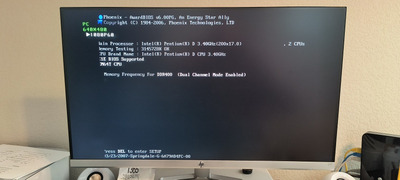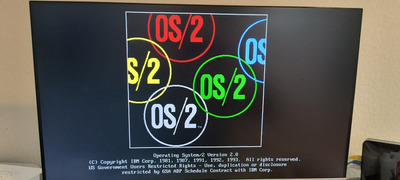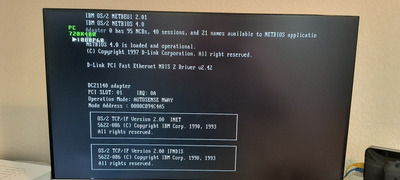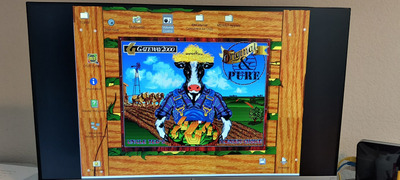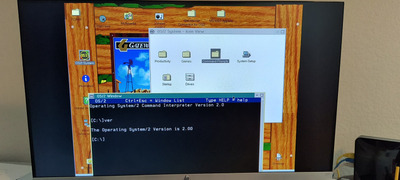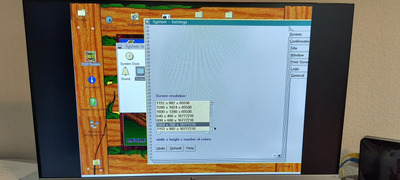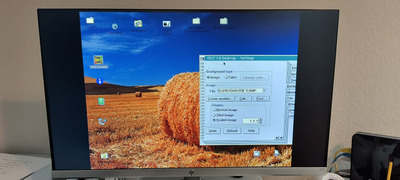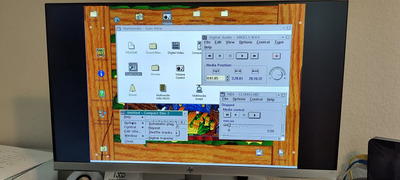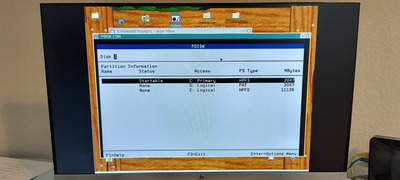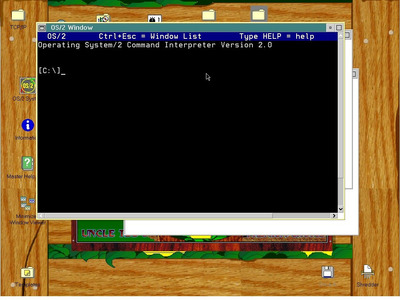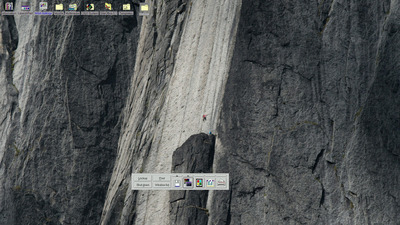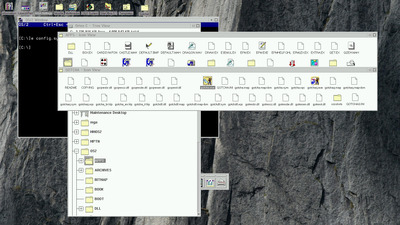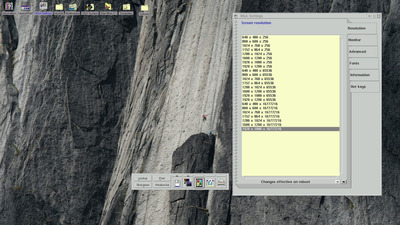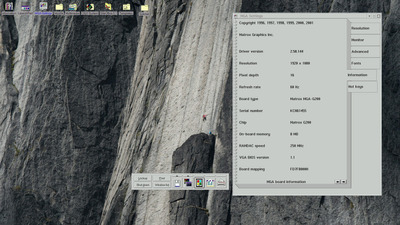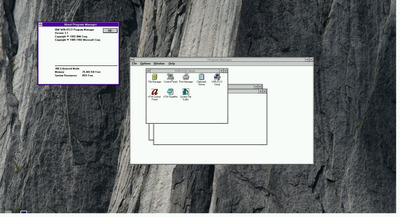First post, by fosterwj03
I decided to spend some time with OS/2 Version 2.0 on my Pentium 4 Retro Rocket this last week. I haven’t seen much discussion on-line about getting such an early version of OS/2 running in any sort of optimum configuration on semi-modern hardware, so I decided to document some observations here. Sorry for the long post.
Bottom line up front:
- OS/2 2.0 can identify, partition, and format large IDE drives (greater than 128GB in size) with IBM’s updated disk drivers from 2003
- OS/2 2.0 can use IDE optical drives with IBM’s updated disk adapter drivers from 2003
- OS/2 2.0 can display at ultra-high resolutions and color depths with Service Pack XR06100 and OS/2 2.x display drivers for compatible hardware
- OS/2 2.0 can provide multimedia capabilities (16-bit audio and MIDI playback) with the MMPM 1.1 package from OS/2 2.1
- OS/2 2.0 can provide rudimentary TCP/IP support and applications with a compatible PCI network card (ISA cards as well)
Hardware in the build:
- Motherboard: DFI/Itox G7S620 (Intel 865P Chipset)
SATA ports set to emulate the Primary IDE channel in the BIOS
AC97 Audio Disabled
On-board LANs (2x Realtek RTL8110) disabled
“OS Select for DRAM > 64MB” set to “OS/2” in the BIOS
- Processor: Pentium D 945 (3.4GHz, 2 Core, 2 Thread)
- Primary IDE Master (SATA Port 1): SATA-to-SD Adapter; 16GB SD Card
- Secondary IDE Master: Generic DVD-ROM Drive
- Secondary IDE Slave: Generic CD-RW Drive
- Floppy: Gotek with FlashFloppy Firmware
- Display: Compaq QVision 2000+ (PCI, Matrox Impression Plus Chipset, 4MB VRAM)
- Audio: Sound Blaster 16 (ISA, CT2230)
- Networking: Dlink DFE-500TX (PCI; DEC 81140 Chipset)
Software:
- Initial OS: OS/2 2.0 General Availability (GA) Installed from Floppy
- Service Pack: XR06100 Installed from Floppy
- MMPM from OS/2 2.1 GA
- LAPS 2.1
- TCP/IP 2.1
- Windows Libraries for OS/2 Version 1.0
Drivers:
- IBM’s Updated Floppy Driver (IBM1FLPY.ADD) from 2003
- IBM’s Updated IDE Adapter Driver (IBM1S506.ADD) from 2003
- IBM’s Updated IDE CD-ROM Filter Driver (IBMIDECD.FLT) from 2003
- IBM’s Updated Disk Management Driver (DASD16.DMD replaces OS2DASD.DMD) from 2003
- IBM’s Updated CD Management Driver (OS2CDROM.DMD) from 2003
- Dlink DFE-500TX OS/2 NDIS2 Driver
- Matrox MGA OS/2 Driver Version 2.1
- Creative Labs Sound Blaster 16 Driver Version 2.20
Initial Installation:
1) I started with the original OS/2 2.0 GA Floppy set from REMOVED.
2) I replaced the “IBM1FLPY.ADD” file on Disk 1 with the version from 2003 to overcome the timing loop error that prevents OS/2 from installing from a floppy drive on fast systems.
3) I replaced the “IBM1S506.ADD” and “OS2DASD.DMD” files on Disk 1 with the versions from 2003 to identify, partition, format, and install on a large disk drive (theoretically, a partition up to 500GB)
4) I booted from the Installation disk and proceed through Disk 1 to the Setup screens.
5) I exited from Setup (once pressing F3 became available to exit) to the OS/2 prompt.
6) I started FDISK.EXE from Disk 1 and created two partitions: 1x 2GB primary partition for the OS and 1x 2GB extended partition for drivers and software.
7) I restarted the computer and booted from the Installation disk and Disk 1 again. When available, I exited to the command prompt a second time.
8 ) I switched to Disk 2 in the Gotek and ran the FORMAT command on both partitions: HPFS for the primary boot partition and FAT16 for the extended partition. HPFS takes a super long time to format in OS/2 2.0. I format partitions outside of the Setup program because I’ve found it a little buggy in the past.
9) I restarted the computer again from the Installation disk for a third time and I proceeded through the initial installation of the OS without reformatting the boot partition.
10) After transferring the system files to prepare for installation, I rebooted with the Installation disk a fourth time. When available, I exited to the command prompt again.
11) Setup did not copy the updated floppy, IDE, and disk management drivers to the hard drive. I copied “IBM1FLPY.ADD”, “IBM1S506.ADD”, and “OS2DASD.DMD” to the “C:\OS2” directory. I removed the floppy from the drive (i.e. removed the USB key from the Gotek), and restarted the computer.
12) I proceeded through the GUI portion of the OS/2 2.0 setup and installed all available components except WIN-OS2 (I’ll explain why later).
13) I completed the installation and booted to a fresh OS/2 desktop.
Updating OS/2 2.0 GA:
1) I prepared a set of Service Pack disks from the XR06100 package (17 floppies).
2) I modified Disk 2 from the Service Pack by replacing “IBM1FLPY.ADD” with the version from 2003 to overcome the timing loop error that prevents OS/2 from installing from a floppy drive on fast systems. The disk did not have room to replace “IBM1S506.ADD” and “OS2DASD.DMD”, but the original Service Pack drivers ended up working well enough to service OS/2 as I partitioned the drive.
3) I booted the computer using Disk 1 of the Service Pack, and I proceeded through the update.
4) After completing the Service Pack installation, I rebooted without a floppy to an updated OS/2 desktop.
Multimedia Installation:
1) I turned the computer off to remove the SD card.
2) I used my daily driver computer to put drivers, software, and updates on the SD card’s FAT16 partition.
3) I re-inserted the SD card into the Retro Rocket and started the computer.
4) I navigated to the FAT16 partition (D: drive) and found the 2003 IBM disk drivers. I copied “IBMIDECD.FLT” and “OS2CDROM.DMD” to the “C:\Os2” directory.
5) I next edited “CONFIG.SYS” by adding the following lines to operate the optical drives:
IFS=CDFS.IFS /Q REM Already included in OS/2 2.0
BASEDEV=IBMIDECD.FLT
DEVICE=C:\Os2\OS2CDROM.DMD
6) I restarted the computer and two optical drives appeared in the “Drives” folder.
7) I next navigated to the D: drive where I placed the MMPM setup directory from Os/2 2.1. I launched MINSTALL.EXE and selected “Sound Blaster” and “CD Player” from the list of drivers.
8 ) During the Sound Blaster portion of the MINSTALL, I selected “Sound Blaster Pro 16” from the list and proceeded through installation. I restarted the computer after installation.
9) Sound didn’t work after the install. I next navigated to the updated Sound Blaster 16 drivers I placed on the D: drive and copied “SB16D2.SYS” to the “C:\MMOS2” directory and “SOUNDB16.DLL” to the “C:\MMOS2\DLL” directory.
10) I next edited the MMPM2.INI file in “C:\MMOS2” per the README.TXT file that came with the Sound Blaster 16 driver.
11) I restarted OS/2, and sound and FM synthesis functioned as expected. Analog CD audio did not play though the Sound Blaster 16, but OS/2’s digital CD audio did play through the Sound Blaster 16.
Display Installation:
Note: Very few video cards support the 16-bit video capabilities that shipped with OS/2 2.0 GA. Service Pack XR06100 updates OS/2 2.0 with 32-bit video capabilities. This service pack allows display drivers written for OS/2 2.1 (32-bit) to run on OS/2 2.0. Unfortunately, these drivers likely expect “Windows 3.1” for “WIN-OS2”. These drivers might (and in my case did in earlier tests) break WIN-OS2 functionality in OS/2 2.0 since it shipped with “Windows 3.0”. That’s why I didn’t bother to install WIN-OS2.
1) I next navigated to the Matrox OS/2 2.1 drivers on the D: drive for my Compaq QVision 2000+. I ran the installation program and replaced the “Primary VGA” driver with the “Matrox MGA” driver.
2) After completing the display driver update, I rebooted into OS/2 with a 640x480 256-color display.
3) The OS/2 “System” utility allowed me to select resolutions up to 1600x1200 in 16-bit color or 24-bit color depths up to 1152x882 resolution thanks to the video card's 4MB of VRAM. I selected 1024x768, 24-bit color for my tests.
Networking Installation:
1) I next navigated to the LAPS folder I placed on the D: drive and ran LAPS.EXE. This transferred the OS/2 networking setup to the C: drive (“C:\IBMCOM”).
2) The LAPS setup program does not allow you to add network card drivers from the GUI, so I existed the setup program at this point.
3) I navigated to my network drivers on the D: drive and copied all of the network cards driver files to “ C:\IBMCOM\Protocol”.
4) I restarted the LAPS.EXE program within “C:\IBMCOM” to configure networking. I selected my DLINK PCI card from the device list and added “IBM OS2 NETBIOS” as a protocol attached to the card. I saved the configuration and restarted OS/2.
5) OS/2 booted properly at this point with my network card configured for network services.
6) I next navigated to the TCPIP installation directory I placed on the D: drive and ran “TCPINST.EXE” from the directory and selected the “BASE TCP/IP Services” from the list of components. This transferred the TCP/IP protocols to the C: drive.
7) When the TCP/IP installation completed, I restarted “LAPS.EXE” from the “C:\IBMCOM” directory to reconfigure my networking. I added “IBM TCP/IP” as a protocol to my network card, manually configured the IP address and router information (except the “nameserver” wasn’t a configurable option at this point), and saved the configuration. I rebooted the computer.
8 ) OS/2 booted properly and the network configured my card for the assigned IP address before entering the GUI.
9) The TCP/IP installation program created a “TCP/IP” folder on the Os/2 desktop. The folder contains a “TCP/IP Configuration” program. I opened this program and configured the “nameserver” for my router in the “Services” tab.
10) I rebooted the computer, and OS/2 ran a nameserver update when entering the GUI. “PING.EXE” and “FTP.EXE” now ran properly with URLs instead of IP addresses.
Software Installation:
1) I navigated to my D: drive, and I ran “INSTALL.COM” file for Microsoft’s WLO applications. The installation routine transferred the WLO apps to the C: drive.
2) I tested several of the WLO Windows apps. Solitaire crashed with the Matrox drivers. Reversi and Clock only operate in 2-bit color. Paint sometimes causes an out-of-memory error depending on the image files size and the display color depth. Notepad and Write appear to operate correctly.
3) I also tried to install IBM’s WebExplorer Version 1.0 to try to get OS/2 on the Web. The program runs, but it crashes with a TCP/IP error when trying to access any website.
4) The only other program I have right now that seems to work with OS/2 2.0 is KLBENCH. It runs on OS/2 2.0 and completes the CPU and Video benchmarks without issue.
Observations:
I find that OS/2 2.0 works well on the Pentium D at 3.4GHz and the G7S620. With the exception the floppy driver replacement, OS/2 2.0 would run on this system without modification. I’m sure later boards that don’t explicitly support OS/2’s memory management would have trouble with OS/2, though.
A lot of documentation online about OS/2 2.0 got published long before IBM updated their drivers. You would get the impression that OS/2 2.0 can’t handle large drives (greater than 512MB, 2GB, 4GB, and/or 8.4GB depending on the article’s dateline) from reading the experience of authors in the mid-to-late 1990. I didn’t expect IBM’s disk adapter drivers from 2003 to work all the way back to OS/2 2.0, but they did. For good measure, I also added a 11GB extended partition and formatted it with HPFS (it did take an hour to format the partition, though).
I do need to mention that IBM’s ATAPI filter driver (IBMATAPI.FLT) from the 2003 driver package will crash OS/2 2.0 hard during boot. I can’t explain the incompatibility, but it just doesn’t work on my system. The IDE CD-ROM driver (IBMIDECD.FLT), on the other hand, works fine. I haven’t tested it yet, but I suspect that the IBM IDE CD-ROM driver will allow me to install OS/2 2.0 GA from a CD if I can define the directory structure on the source CD drive the way the Setup program expects. In fact, the DANIBOOT driver might even make it possible to CD-boot and install all from the same CD.
Finally, I haven’t seen any mention of OS/2 2.0 GA running multimedia applications anywhere on the net. IBM released a later version (2.0.1) for multimedia PCs, but it doesn’t seem like anyone bothered to try with an earlier version. I installed the multimedia features in this latest work after the service pack to save time, but I have installed the multimedia feature before the service pack in the past. Multimedia does work with the GA version without issue.
That’s about it for now. OS/2 2.0 is still a bit too old to be truly usable. Some 32-bit software I’ve found requires version 2.1 at a minimum, and most requires Warp 3.0 or later. Still, it’s always fun to experiment. I added a couple of photos from my monitor. If anyone knows a good screen capture utility that works in OS/2 2.0, I’d appreciate hearing about it.
